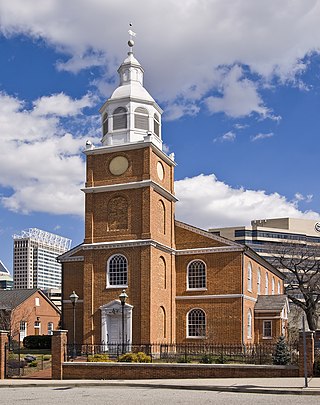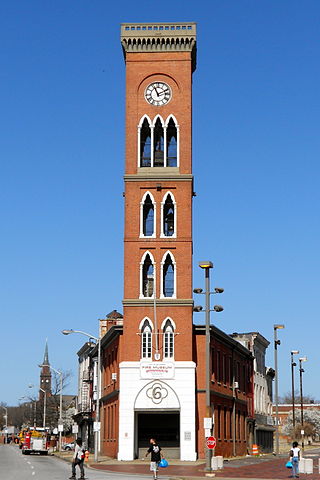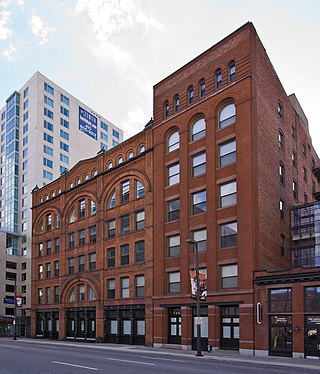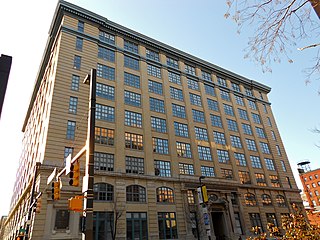
Pajamas (US) or pyjamas (Commonwealth), sometimes colloquially shortened to PJs, jammies, jim-jams, or in South Asia night suits, are several related types of clothing worn as nightwear or while lounging or performing remote work from home. Pajamas are soft garments derived from the Indian and Persian bottom-wear, the pyjamas. They originated in the Indian subcontinent and were adopted in the Western world as nightwear.

The Baltimore–Washington Parkway is a highway in the U.S. state of Maryland, running southwest from Baltimore to Washington, D.C. The road begins at an interchange with U.S. Route 50 (US 50) near Cheverly in Prince George's County at the Washington, D.C. border, and continues northeast as a parkway maintained by the National Park Service (NPS) to MD 175 near Fort Meade, serving many federal institutions. This portion of the parkway is dedicated to Gladys Noon Spellman, a representative of Maryland's 5th congressional district, and has the unsigned Maryland Route 295 (MD 295) designation. Commercial vehicles, including trucks, are prohibited within this stretch. This section is administered by the NPS's Greenbelt Park unit. After leaving park service boundaries the highway is maintained by the state and signed with the MD 295 designation. This section of the parkway passes near Baltimore–Washington International Thurgood Marshall Airport. Upon entering Baltimore, the Baltimore Department of Transportation takes over maintenance of the road and it continues north to an interchange with Interstate 95 (I-95). Here, the Baltimore–Washington Parkway ends and MD 295 continues north unsigned on Russell Street, which carries the route north into downtown Baltimore. In downtown Baltimore, MD 295 follows Paca Street northbound and Greene Street southbound before ending at US 40.

Mount Vernon is a neighborhood of Baltimore, Maryland, located immediately north of the city's downtown district. Designated a city Cultural District, it is one of the oldest neighborhoods originally home to the city's wealthiest and most fashionable families. The name derives from Mount Vernon, the home of George Washington, given the original Washington Monument, a massive pillar commenced in 1815 to commemorate the first president of the United States, is the defining feature of the neighborhood.

Canton is a historic waterfront neighborhood in Baltimore, Maryland, United States. The neighborhood is along Baltimore's outer harbor in the southeastern section of the city, roughly two miles east of Baltimore's downtown district and next to or near the neighborhoods of Patterson Park, Fell's Point, Highlandtown, and Brewers Hill.

Brewers Hill is a neighborhood in the Southeast District of Baltimore, Maryland, United States.

Seton Hill Historic District is a historic district in Baltimore, Maryland. It was listed on the National Register of Historic Places in 1975.

Otterbein Church, now known as Old Otterbein United Methodist Church, is a historic United Brethren church located in Baltimore, Maryland, United States. The first "German Reformed" church was built to serve the German Reformed and some Evangelical Lutheran immigrants, and later entered the Brethren strain of German Reformed Protestantism in the later Church of the United Brethren in Christ.

Engine House No. 8 was a historic fire station located at Baltimore, Maryland, United States. It was a two-story masonry building with a cast-iron street front, erected in 1871 in the Italianate style. The front featured a simple cornice with a central iron element bearing the legend "No. 8". Engine Company No. 8 operated from this building until 1912. In 1928 it became the motorcycle shop of Louis M. Helm and the upper story functioned as a clubhouse for a series of boys’ clubs into the 1940s.

Engine House No. 6 is a historic fire station located at Baltimore, Maryland, United States. This two-story brick building features a 103-foot Italian-Gothic tower at the apex of its truncated triangular shape. It was built in 1853–54, and the tower is said to be a copy of Giotto's campanile in Florence, Italy.

Erlanger Buildings is a historic loft building located at Baltimore, Maryland, United States. It consists of a four-structure, turn-of-the-20th-century loft complex. The buildings range in size from two to six stories high and feature iron storefronts and stone detailing. They were built between 1892 and 1910. The buildings served as the home of the Erlanger Manufacturing Company, which produced BVD brand underwear. Charles Erlanger, co-founder of the company, is credited with making major advances in the design of underwear which revolutionized the industry.

Gandy Belting Company Building is a historic loft building located at Baltimore, Maryland, United States. It is a brick masonry bearing-wall structure built in five sections. The sections built in 1888, 1890, and 1908 are four stories in height. The remaining two sections, built in 1908-1911 and 1911 respectively, are five stories in height. The Gandy Belting Company, (1888-1931) manufacturer of machinery belting.

Heiser, Rosenfeld, and Strauss Buildings, also known as Inner Harbor Lofts I, is a historic loft building located at Baltimore, Maryland, United States. It is a complex of three structures. The Heiser Building is a Romanesque Revival style, six-story brick, stone, and iron structure, eight bays wide and 14 bays deep, built as a show factory in 1886. The Rosenfeld Building is a six-story, five-bay loft building, with Beaux Arts styling and built for E. Rosenfeld and Company in 1905. The Strauss Building is a six-story high, six-bay wide, and 11-bay deep loft structure built in 1887 for the Kinny Tobacco Company, cigarette manufacturers, and later occupied by the Strauss Brothers, clothing manufacturers and became part of the Rosenfeld complex around 1910.

The Pratt Street Power Plant — also known as the Pier Four Power Plant, The Power Plant, "Pratt Street Toenail", and Pratt Street Station — is a historic former power plant located in downtown Baltimore, Maryland, USA. It has undergone significant repurposing development since retirement and was listed on the National Register of Historic Places in 1987.

Lion Brothers Company Building is a historic factory located at 875 Hollins St, Baltimore, Maryland 21201. It is a multi-level building that once housed the operations of the Lion Brothers embroidery company. The original building was constructed in 1885 and expanded several times over the subsequent 75 years. In 1958 the Lion Brothers moved their production facility to another location allowing Marcus & Farber and Globe Screen Printing to move in. The building has been vacant since 2002 and Cross Street Partners has plans to restore the building as a local innovation center.

Maryland White Lead Works is a historic lead paint factory complex located at Baltimore, Maryland, United States. It is a "U"-shaped industrial complex constructed about 1867. It consists of nine interconnected brick and wood-frame buildings, which vary in height from one to four stories, surrounding a yard. The complex includes the powerhouse, two production sheds, a manufactory loft with an office wing, and a service building. The Maryland White Lead Company occupied the site from 1867 to 1896, Baltimore's first and most substantial manufacturer of lead paints.

Sonneborn Building, also known as Paca-Pratt Building, is a historic loft building in Baltimore, Maryland, United States. Designed by Theodore Wells Pietsch, it is a nine-story loft building constructed in 1905 of "fireproof" reinforced-concrete construction, faced in buff-colored brick, with a coursed ashlar foundation and stone trim. Its detailing reflects the Neoclassical Revival of the early 20th century. It was built for Henry Sonneborn and Company as a vertical clothing manufactory and was the tallest and largest strictly manufacturing building in the city of Baltimore.

The Loft Historic District North is a national historic district in Baltimore, Maryland, United States. It includes 12 large 19th–early 20th century vertical brick manufacturing buildings centering on Paca, Redwood, and Eutaw Streets near the University of Maryland Campus in downtown Baltimore. Most of the buildings are still used for manufacturing purposes, although a few, including the Heiser, Rosenfeld, and Strauss buildings, have been converted into loft apartments or offices. They are representative of Romanesque, Victorian, and early modern industrial architectural design. It was in this area that Baltimore's garment industry grew to national importance.
J. Harleston Parker was an American architect active in Boston, Massachusetts.

Parker, Thomas and Rice and Parker & Thomas were architectural firms formed in the early 20th century by partners J. Harleston Parker, Douglas H. Thomas, and Arthur W. Rice.

The Thomas Driver and Sons Manufacturing Company is a complex of two historic factory buildings in downtown Racine, Wisconsin. The Thomas Driver and Sons manufacturing company itself was a manufacturer of sash windows and doors that was first established in 1867. The buildings, located at 134 South Main Street and 214 State Street, are on opposite sides of Second Street. The site was added to the National Register of Historic Places on July 14, 2004.




















